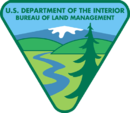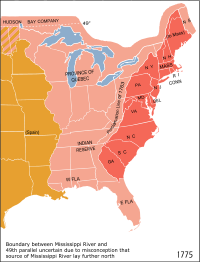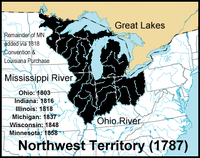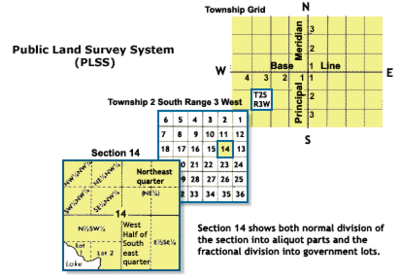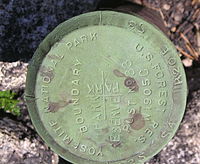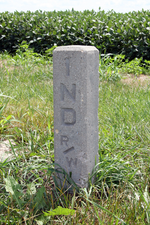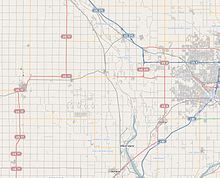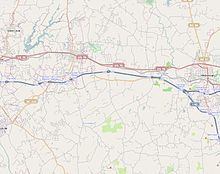- Public Land Survey System
-
The Public Land Survey System (PLSS) is a method used in the United States to survey and identify land parcels, particularly for titles and deeds of rural, wild or undeveloped land. Its basic units of area are the township and section. It is sometimes referred to as the rectangular survey system, although non rectangular methods such as meandering can also be used. The survey was "the first mathematically designed system and nationally conducted cadastral survey in any modern country" and is "an object of study by public officials of foreign countries as a basis for land reform."[1] The detailed survey methods to be applied for the PLSS are described in a series of Instructions and Manuals issued by the General Land Office beginning in 1851,[2] the latest edition being the "The Manual of Instructions for the Survey of the Public Lands of the United States, 20089989" available from the U.S. Government Printing Office.
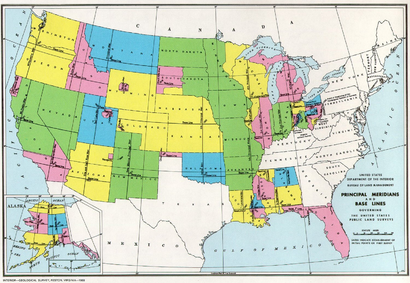 Figure 1. This BLM map depicts the principal meridians and baselines used for surveying states (colored) in the PLSS.
Figure 1. This BLM map depicts the principal meridians and baselines used for surveying states (colored) in the PLSS.
Contents
History of the system
 Monument referencing the beginning point of the PLSS
Monument referencing the beginning point of the PLSS
Originally proposed by Thomas Jefferson to create a nation of "yeoman farmers”,[3] the PLSS began shortly after the American Revolutionary War. The Land Ordinance of 1785 was the beginning of the Public Land Survey System. The Continental Congress was deeply in debt following the Declaration of Independence. With little power to tax, the federal government decided to use the sale of the Western Territories to pay off American Revolutionary War debt. It has been expanded and slightly modified by Letters of Instruction and Manuals of Instruction, issued by the General Land Office and the Bureau of Land Management and continues in use in most of the states west of Pennsylvania, south to Florida, Alabama, and Mississippi, west to the Pacific Ocean, and north into the Arctic in Alaska.
Origins of the system
The original colonies (including their derivatives Maine, Vermont, Tennessee, Kentucky and West Virginia) continued the British system of metes and bounds. This system describes property lines based on local markers and bounds drawn by humans, often based on topography. A typical, yet simple, description under this system might read "From the point on the north bank of Muddy Creek one mile (1.6 km) above the junction of Muddy and Indian Creeks, north for 400 yards, then northwest to the large standing rock, west to the large oak tree, south to Muddy Creek, then down the center of the creek to the starting point."
Particularly in New England, this system was supplemented by drawing town plats. The metes-and-bounds system was used to describe a town of a generally rectangular shape, 4 to 6 miles (~6 to 10 km) on a side. Within this boundary, a map or plat was maintained that showed all the individual lots or properties.
There are some difficulties with this system:
- Irregular shapes for properties make for much more complex descriptions.
- Over time, these descriptions become problematic as trees die or streams move by erosion.
- It wasn't useful for the large, newly surveyed tracts of land being opened in the west, which were being sold sight unseen to investors.
In addition this system didn't work until there were already people on the ground to maintain records. In the 1783 Treaty of Paris recognizing the United States, Britain also recognized American rights to the land south of the Great Lakes and west to the Mississippi River.
The Continental Congress passed the Land Ordinance of 1785 and then the Northwest Ordinance in 1787 to control the survey, sale, and settling of the new lands. The original 13 colonies donated their western lands to the new Union, for the purpose of giving land for new states. These include the lands that formed the Northwest Territory, Kentucky, Tennessee, Alabama, and Mississippi. The state that gave up the most was Virginia, whose original claim included most of the Northwest Territory and Kentucky, too. Some of the western land was claimed by more than one state, especially in the Northwest, where parts were claimed by Virginia, Pennsylvania, and Connecticut, all three of which had claimed lands all the way to the Pacific Ocean.
Applying the system
The first surveys under the new rectangular system were in eastern Ohio in an area called the Seven Ranges.
The Beginning Point of the U.S. Public Land Survey is located at a point on the Ohio-Pennsylvania border between East Liverpool, Ohio and the Pittsburgh metropolitan area, on private property. A National Historic Landmark marker commemorating the site lies on the side of a state highway, exactly 1,112 feet (339 m) to the north of the point.[4]
Ohio was surveyed in several major subdivisions, collectively described as the Ohio Lands, each with its own meridian and baseline. The early surveying, particularly in Ohio, was performed with more speed than care, with the result that many of the oldest townships and sections vary considerably from their prescribed shape and area. Proceeding westward, accuracy became more of a consideration than rapid sale, and the system was simplified by establishing one major north-south line (principal meridian) and one east-west (base) line that control descriptions for an entire state or more. For example, a single Willamette Meridian serves both Oregon and Washington. County lines frequently follow the survey, so there are many rectangular counties in the Midwest and the West.
Non-PLSS regions
The system is in use in some capacity in most of the country, but large portions use other systems.
The territory under the jurisdiction of the Thirteen Colonies at the time of independence did not adopt the PLSS, with the exception of the area that became the Northwest Territory and some of the Southern states. This territory is now Georgia, Connecticut, Delaware, Kentucky, Maine, Maryland, Massachusetts, New Hampshire, New Jersey, New York, North Carolina, Pennsylvania, Rhode Island, South Carolina, Tennessee, Vermont, Virginia, and West Virginia.
The old Cherokee lands in Georgia use the term section as a land designation, but does not define the same area as the section used by the PLSS.
Maine uses a variant of the system in unsettled parts of the state.
Other major exceptions to PLSS are
- California, before statehood in 1850, surveyed only the boundaries of Spanish land grants (ranchos); since statehood the PLSS system has been used mostly throughout.
- Hawaii adopted a system based on the Kingdom of Hawaii native system in place at the time of annexation.
- Louisiana recognizes early French and Spanish descriptions called arpents, particularly in the southern part of the state, as well as PLSS descriptions.
- New Mexico uses the PLSS, but has several areas that retain original metes and bounds left over from Spanish and Mexican rule. These take the form of land grants similar to areas of Texas and California.
- Ohio's Virginia Military District was surveyed using the metes and bounds system. Areas in northern Ohio (primarily what originally was the Connecticut Western Reserve) were surveyed with an earlier standard, often referred to as Congressional Survey townships, which are just five miles (8 km) on each side instead of six. Hence, there are 25 sections per township there, rather than 36.
- Texas has a hybrid of its own early system, based on Spanish land grants, and a variation of the PLSS.
- Wisconsin had French settlement prior to the PLSS in the areas of Green Bay and Prairie du Chien. Both have small amounts of the long, narrow French lots along some water frontage.
- Michigan had French settlement prior to the PLSS along the Detroit and St. Clair rivers, and near Sault Ste. Marie, Marquette, and Ypsilanti. These were all examples of the French "long lots".
Mechanics
Commonly used PLSS terms[3]
- Aliquot part: The standard subdivisions of a section, such as a half section, quarter section, or quarter-quarter section.
- Base line: A parallel of latitude, or approximately a parallel of latitude, running through an arbitrary point chosen as the starting point for all sectionalized land within a given area.
- Cadastral: Having to do with the boundaries of land parcels.
- Government lot: A subpart of a section which is not described as an aliquot part of the section, but which is designated by number, for example, Lot 3. A lot may be regular or irregular in shape, and its acreage may vary from that of regular aliquot parts. These lots frequently border water areas excluded from the PLSS.
- Initial point: The starting point for a survey.
- Land grant: A land grant is an area of land to which title was conferred by a predecessor government and confirmed by the U.S Government after the territory in which it is situated was acquired by the United States. These lands were never part of the original public domain and were not subject to subdivision by the PLSS.
- Principal meridian: A meridian line running through an arbitrary point chosen as a starting point for all sectionalized land within a given area.
- Public domain: Land owned by the Federal government for the benefit of the citizens. The original public domain included the lands that were turned over to the Federal Government by the Colonial States and the areas acquired later from the native Indians or foreign powers. Sometimes used interchangeably with Public lands.
- Public lands: Lands in public ownership, therefore owned by the Federal government. Sometimes used interchangeably with Public domain.
- Range: A vertical column of townships in the PLSS.
- Section: A one-square-mile block of land, containing 640 acres, or approximately one thirty-sixth of a township. Due to the curvature of the Earth, sections may occasionally be slightly smaller than one square mile.
- Township: An approximately 6-mile (9.7 km) square area of land, containing 36 sections. Also, a horizontal row of townships in the PLSS.
- Witness corner: A marker set on a property line, near a corner. The witness corner is used when it is impossible to place a monument in the exact location of a section, quarter, or sixteenth corner.
Summary of objects and data required to be noted during survey[5]
- The precise length of every line run, noting all necessary offsets therefrom, with the reason and mode thereof.
- The kind and diameter of all "bearing trees”, with the course and distance of the same from their respective comers; and the precise relative position of witness corners to the true corners.
- The kinds of materials (earth or stone) of which mounds are constructed—the fact of their being conditioned according to instructions - with the course and distance of the "pits", from the centre of the mound, where necessity exists for deviating from the general rule.
- Trees on line. The name, diameter, and distance on line to all trees which it intersects.
- Intersections by line of land objects. The distance at which the line first intersects and then leaves every settler's claim and improvement; prairie; river, creek, or other "bottom"; or swamp, marsh, grove, and wind fall, with the course of the same at both points of intersection; also the distances at which you begin to ascend, arrive at the top, begin to descend, and reach the foot of all remarkable hills and ridges, with their courses, and estimated height, in feet, above the level land of the surrounding country, or above the bottom lands, ravines, or waters near which they are situated.
- Intersections by line of water objects. All rivers, creeks, and smaller streams of water which the line crosses; the distance on line at the points of intersection, and their widths on line. In cases of navigable streams, their width will be ascertained between the meander corners, as set forth under the proper head.
- The land's surface - whether level, rolling, broken, or hilly.
- The soil - whether first, second, or third rate.
- Timber - the several kinds of timber and undergrowth, in the order in which they predominate.
- Bottom lands - to be described as wet or dry, and if subject to inundation, state to what depth.
- Springs of water - whether fresh, saline, or mineral, and the course of the stream flowing from them.
- Lakes and ponds - describing their banks and giving their height, and also the depth of water, and whether it be pure or stagnant.
- Improvements. Towns and villages; Indian towns and wigwams; houses or cabins; fields, or other improvements; sugar tree groves, sugar camps, mill seats, forges, and factories.
- Coal banks or beds; peat or turf grounds; minerals and ores; with particular description of the same as to quality and extent, and all diggings therefore; also salt springs and licks. All reliable information you can obtain respecting these objects, whether they be on your immediate line or not, is to appear in the general description to be given at the end of the notes.
- Roads and trails, with their directions, whence and whither.
- Rapids, cataracts, cascades, or falls of water, with the height of their fall in feet.
- Precipices, caves, sink-holes, ravines, stone quarries, ledges of rocks, with the kind of stone they afford.
- Natural curiosities, interesting fossils, petrifactions, organic remains, also all ancient works of art, such as mounds, fortifications, embankments, ditches, or objects of like nature.
- The variation of the needle must be noted at all points or places on the lines where there is found any material change of variation, and the position of such points must be perfectly identified in the notes.
Survey design and protocol
The surveying of any regional area is a multi-step process. First, two controlling survey lines are established for some relatively large area: a baseline, which runs east-west and a principal meridian, which runs north-south (Fig. 1). These two lines pass through, and intersect at, a location known as an initial point. Next, at a defined distance interval, commonly 24 or 30 miles (48 km) depending on the year and location, standard parallels are established parallel to the baseline. The meridian, baseline and standard parallels thus established form a lattice upon which all further surveying is then based. Subsequent work divides the land into survey townships of roughly 36 square miles (~93 km2) or 6 miles (~9.7 km) on each side. This is done by the establishing of township and range lines, which run parallel to the baseline and principal meridian, respectively, at six mile (10 km) intervals. Lastly, townships are subdivided into 36 sections of one square mile (640 acres, ~2.6 km2) and 144 quarter-sections of 0.25 square mile (160 acres, ~0.65 km2) each. (See descriptions and figures illustrating the system). The federal government typically surveys only to the quarter-section level; smaller parcels are usually surveyed later by private surveyors if necessary.
 Figure 2. This General Land Office diagram shows the theoretical sectioning of a standard survey township.
Figure 2. This General Land Office diagram shows the theoretical sectioning of a standard survey township.
The townships and sections are indexed based on the township's position relative to the initial point and the section's location within the designated township. Township, range, and section are abbreviated as T, R, and S, respectively, and cardinal bearings from the initial point by N, S, E, and W, and each principal meridian has its abbreviation. Thus, for example, S13-T1S-R20E MDM refers to: Section 13, Township 1 South, Range 20 East, Mount Diablo Meridian, or the 13th section in the first township south of the baseline and 20th township east of the principal meridian. The sections within a township are numbered boustrophedonically (Fig. 2). Starting in the northeast corner, sections in the first row (sections 1-6) are numbered east to west, those in the second row (sections 7-12) are numbered west to east, the direction continuing to alternate with each row, until section 36 is reached in the southeast corner. Distances were measured using chains and links based on Edmund Gunter’s chain for plotting ground. A chain was made up of 100 links. Each link measured 7.92 inches (201 mm). Each chain measured 66 feet (20 m) long. 80 chains equal one U.S. Survey Mile. NOTE: A U.S. Survey Mile differs from the International Mile by a few millimeters. In areas where measuring by chain was not possible, such as variable elevated terrain or terrain with water obstructions, distance was calculated using triangulation. The importance of the PLSS is one of the many barriers to metrication of property title in the United States.
The intersection of a township line with a range line is called a township corner, of a section line with another section, township or range line a section corner, and a point halfway between two section corners a quarter corner. At each such corner, a corner monument is established to mark the location of the corner on the ground. This monument is the legally binding mark used for setting property lines; it is the culminating work of the entire survey. As with most surveying specifications, those for the corners have changed over time. In the 19th century, the monuments were commonly a rock pile, a wooden post, or a combination of the two. Trees were also sometimes used when available. In the 20th century, steel pipes with caps, supported by mounds of rock, became required (e.g. Fig. 3). Monuments are always witnessed to by the marking of other nearby natural objects on the ground. These witnesses can be trees, rocks, or trenches dug in the ground; the exact locations of the witness objects, and the markings made on them, are recorded in the surveyor's official field notes. Witness trees are commonly referred to as bearing trees, and they are highly important, not just for their legal purposes, but also for their use by ecologists in the estimation of historic forest vegetation conditions. The witness objects are designed to allow subsequent surveyors and landowners to find the original corner monument location should the actual monument be destroyed. It was not uncommon for squatters or homesteaders to destroy corner monuments if they felt the patenting of the land would threaten their residence on it. For this reason, destruction of corner monuments or their witness objects is a federal offense.
 Figure 4. Kent County, Michigan in 1885 as a PLSS example, showing 24 named townships and sectional subdivisions.
Figure 4. Kent County, Michigan in 1885 as a PLSS example, showing 24 named townships and sectional subdivisions.
Because the grid is flat and the earth is round, adjustments must be made periodically; not all sections can be one square mile nor can all townships be exactly 36 square miles. These adjustments are done within each township by starting the sectional surveys of the township in the southeast corner and moving progressively toward the northwest corner. The northernmost and westernmost tier of sections—11 in all—are allowed to deviate from one square mile, but the other 25 are not. This method accommodates the curvature effects, and also allows for the correction of errors made during the surveying—which were not uncommon—without overly compromising the rectangular nature of the system.
Understanding property descriptions
The description of a particular ten acre parcel of land under this system might be given as NW1/4 SW1/4 SE1/4 SEC 22 T2S R3E. The elements of such descriptions are interpreted from right to left, so we are describing a plot of land in the township that is the third east of the Range Line (R3E) and the second south of the base line (T2S). We are also looking at section 22 in that township (refer to the grid above). Next that section is divided into quarters (160 acres each), and we should be in the SE quarter section. That section is divided again in quarters (40 acres) and the description calls for the SW quarter. Last in this description, it is quartered again (into 10 acre plots), as we want the NW quarter.
So, in language, the example plot is the NW quarter of the SW quarter of the SE quarter of section 22 of the township that is the second south of the base line and the third east of the range line. Some descriptions will use other references such as S½ to refer to the south half of a quarter section. As an area became settled a township and county name might replace the range and base line numbers, but they can always be traced backwards.
Some western states have only one base line. (Notice that these states have straight line borders to the north or south.) This means that all the townships in the state are either north or south. (The base line for survey of the Kansas and Nebraska territories was the 40th parallel dividing them.) They also typically have only one principal meridian. (For examples, the Kansas range line is 97° west of Greenwich). In the Maine variant of the system, the range line is called the "East Line of State"; all ranges are to the west of this line, and are normally written TxRx WELS, or "West from East Line of State".
Sizes of PLSS subdivisions
The following table indicates some distance and area conversions in the PLSS:
dimensions
(miles)
(mile2)area
(acres)
(m2)
(km2)notes Quadrangle 24 by 24 576 368,640 1,492 Usually 16 townships Township 6 by 6 36 23,040 93 Usually 36 sections Section 1 by 1 1 640 2.6 Half-section 1 by 1⁄2 1⁄2 320 1,294,994 1.3 Quarter-section 1⁄2 by 1⁄2 1⁄4 160 647,497 Half of quarter-section 1⁄2 by 1⁄4 1⁄8 80 323,749 Quarter of quarter-section 1⁄4 by 1⁄4 1⁄16 40 161,874 List of meridians
Social impact
Railroad land grants
The Pacific Railroad Act of 1862 (signed by President Abraham Lincoln) was the first major land grant specifically for the transcontinental railroad. This act provided surveyed, public lands for a railroad right-of-way to build rail systems, and millions acres to raise the capital needed to build and maintain the future railways. Ten square miles of land on each side of the proposed rail track were granted for every one mile of completed railway. The U.S. Public Land Survey System was utilized for measurement. Every one-mile railway completed was akin to a section. If the railway ran predominantly east and west, a 10 miles (16 km) range of one square mile sections were allotted on each side of the 400-foot (120 m) right-of-way. If the railway ran predominantly north and south, a 10 miles (16 km) township of one square mile sections were allotted on each side of the 400-foot (120 m) right-of-way. The land was granted in alternating sections (one square mile). Each odd numbered section going to the railroad company. Each even numbered section kept by the government. This created a checkerboard pattern along proposed rail way. This was supposed to guarantee that railroad access would increase the value of not only the railroad granted sections, but also the government owned sections in the checkerboard. The system was devised by Senator Stephen A. Douglas, with political support from Senator Jefferson Davis[6].
Education
Under the 1785 act, section 16 of each township was set aside for school purposes, and as such was often called the school section. Section 36 was also subsequently added as a school section in western states.[7] The various states and counties ignored, altered or amended this provision in their own ways, but the general (intended) effect was a guarantee that local schools would have an income and that the community schoolhouses would be centrally located for all children. An example of land allotments made specifically for higher education is Ohio's College Township.
Metric system adoption
The U.S. Public Land Survey System is considered one of the major points of contention in the adoption of the metric system in the United States. The U.S. Public Land Survey System has used the Gunter's chain as a basic measurement.
"...the measurements of every plot of ground in the United States have been made in acres, feet, and inches, and are publicly recorded with the titles to the land according to the record system peculiar to this country." —Franklin Institute of Philadelphia (1876). Because of this, redefining property boundaries could create a large amount of legal issues and property owner confusion. Many local zoning laws are defined in feet/square feet. Conversion of units for surveyors are not always simple and complex decisions are frequently required (non-universal conversion factors, soft/hard conversions, number rounding).
Example of road system in a PLSS area; Nebraska Example of road system in a non-PLSS area; North Carolina
Example of road system in a non-PLSS area; North Carolina
Urban design
As roads have typically been laid out along section boundaries spaced one mile (1.6 km) apart, growing urban areas have adopted road grids with mile-long "blocks" as their primary street network. Such roads in urban areas are known as arterials or section line roads, usually designed primarily for automobile travel and limited in their use for non-motorized travel. In post-World War II suburbs, commercial development has largely occurred along and at intersections of arterials, while the rest of the former square-mile sections have generally filled with residential development, as well as schools, religious facilities, and parks. One example of this is famous Mile Road System of Detroit, Michigan.
Occasionally, and more frequently in a metropolitan region's inner postwar suburbs than in outer areas, arterials are located at approximately half-mile intervals. This strictly regimented urban (or suburban) structure has coincided with the similarly strict practice of Euclidean zoning (named after the town of Euclid, Ohio, which won a 1926 Supreme Court case Village of Euclid, Ohio v. Ambler Realty Co., which established the constitutionality of zoning). In Euclidean zoning, use of a property is dictated and regulated by zoning district, the boundaries of which are often based on locations of arterials.
West of the Appalachians, road systems frequently follow the PLSS grid structure (see illustrations of Nebraska vs North Carolina on left). The results can be 90-degree intersections and very long stretches of straight roads.[8][9]
Popular culture
The land system is an important part of American history and culture. Among other things, the stock phrases "lower 40", "front 40", "back 40", and "40 acres and a mule", which are sometimes heard in American movies, reference the quarter-quarter section.
- The "lower 40" in a quarter-section is the one at lowest elevation, i.e. in the direction that water drains. The "lower 40" is frequently the location of or the direction of a stream or a pond.
- The phrase "40 acres and a mule" was the compensation apocryphally promised by the Freedman's Bureau following the American Civil War.
- The idea of 40 work days in an acre came from a Gunter's chain calculation. At the time of the Homestead Act, four square perch (33 ft × 33 ft) = one work day.
- RKO Forty Acres was a film studio backlot for filming movies and TV shows such as King Kong, Gone With The Wind and Star Trek.[10]
- 40 Acres & A Mule Filmworks is the production company of noted American filmmaker Spike Lee.
- Homesteading, another staple of American western culture, was also dependent on the Public Land Survey System. In the original Homestead Act of 1862, during the Lincoln Administration, each settler was allocated 160 acres (0.65 km2) of land; in other words, a quarter-section.
- Later amendments of the Homestead Act allocated more land, as much as 640 acres (2.6 km2); in other words, a section. This was a good revision to apply to land that was drier or more desolate than the earlier, more desirable lands already settled. Many times, this land was more suited to ranching than to farming.
- The hodag is a mythical creature and the mascot of Rhinelander, Wisconsin, created by Gene Shepard in 1893. A specimen of the creature was claimed to have been found in section 37 of a local township; a township contains only 36 sections.
Notes
- ^ Joseph S. Mendinghall (December 27, 1974), National Register of Historic Places Inventory-Nomination: Beginning Point / Beginning Point of the U.S. Public Land Survey, National Park Service, http://pdfhost.focus.nps.gov/docs/NHLS/Text/66000606.pdf
- ^ C. Albert White. A History of the Rectangular Survey System, page 115
- ^ a b http://www.nationalatlas.gov/articles/boundaries/a_plss.html
- ^ Inscription on monument, pictured here
- ^ http://books.google.com/books?id=1X1VAAAAMAAJ&ots=yVuKwyy54l&dq=theory%20and%20practice%20of%20surveying%201913&pg=PP1#v=onepage&q&f=false J. B. Johnson, Leonard S. Smith; The Theory And Practice of Surveying, Wiley & Sons, New York, 1913
- ^ Julian E. Zelizer, The American Congress: the building of democracy, [p.287-288
- ^ http://www.land.state.az.us/history.htm "Act of Congress,February 24, 1863, granted sections 16 and 36 of each township for the benefit of the common schools"
- ^ http://www.uctc.net/papers/878.pdf
- ^ http://web.ics.purdue.edu/~duffy/IE486.../IE486_p14_Accid%20Anal%20Prv.pdf
- ^ http://www.retroweb.com/40acres.html "40 Acres" - RetroWeb Studio Backlots website"
See also
- Groma surveying
- Benson Syndicate
- Dominion Land Survey (Canada)
- General Land Office
- Section (United States land surveying)
- State Plane Coordinate System
- Surveying
- Beginning Point of the U.S. Public Land Survey
- Beginning Point of the Louisiana Purchase Survey
- Lot and Block survey system
Meridians in the United States
References
- Andro Linklater, Measuring America: How an Untamed Wilderness Shaped the United States and Fulfilled the Promise of Democracy, New York: Walker & Co., 2002. ISBN 0-8027-1396-3 (softbound ISBN 0-452-28459-7) (Describes the history and social context of the PLSS and some of the political maneuvering that went into its creation.)
- Curt Meine. Correction Lines: Essays on Land, Leopold, and Conservation. Washington, D.C.: Island Press, 2004.
- William Pattison, Beginnings of the American Land Survey System, 1784–1800, Geography Research Paper (Chicago: University of Chicago, 1957).
- Norman J. W. Thrower, Original Survey and Land Subdivision: A Comparative Study of the Form and Effect of Contrasting Cadastral Surveys (Chicago: published for the Assn of American Geographers by Rand McNally, 1966).
- Payson J. Treat. The National Land System, 1785-1820. New York: E.B. Treat, 1910 (Reprinted in 1967 and 2003) ISBN 1-57588-797-5
- C. Albert White. A History of the Rectangular Survey System. Washington: U.S. Dept. of the Interior, Bureau of Land Management : For sale by Supt. of Docs., U.S. G.P.O., 1983
- Andro Linklater, Measuring America: How the United States Was Shaped by the Greatest Land Sale in History, New York: Plume, September 30, 2003. ISBN 0452284597 (paperback).
External links
- LSD + GPS + UTM coordinates (batch) conversion Free map convertors & tools
- Bureau of Land Management
- Manual of Instructions for the Survey of the Public Lands of the United States, 2009
- Manual of Instructions for the Survey of the Public Lands of the United States, 1973 (as PDF) - Official manual for PLSS
- Resources page of the U.S. Department of the Interior, Bureau of Land Management
- National Land Information System (NILS) - Cadastral records and land parcel information including GeoCommunicator below
- NILS GeoCommunicator - Cadastral records and land parcel information
- The Public Land Survey System (PLSS) - general reference in the nationalatlas.gov (National Atlas of the United States)
- U.S. Geological Survey
- National Geodetic Survey
- American Congress on Surveying & Mapping
- Township and Range - Public Land Survey System on Google Earth - convert latitude/longitude to township and range
- TRS data to latitude/longitude calculator - for 17 western U.S. states
- www.resurvey.org - reference for land surveyors working in the PLSS
- Federal Township Plats of Illinois, 1804-1891 from the Illinois State Archives
- Researching New Mexico Land Grants
- IIC Minnesota Historical Vegetation
- The Minnesota Bearing Tree Database
- The Principal Meridian Project
- Locating Oil or Gas Wells Using The Federal Township and Range System
- Lists of the coordinates used for section corners in Kansas City, Missouri
- Wisconsin State Cartographer's Office - Curiosities and trivia about the PLSS
- Public Land Survey System in Google Earth - a free Google Earth implementation of the National Integrated Land System (NILS) GeoCommunicator map service
- EarthPoint Google Earth - KML files for PLSS and other grid systems
- Sample of PLSS in ESRI ArcGIS - Alabama PLSS
Categories:- Land surveying of the United States
- Real estate in the United States
Wikimedia Foundation. 2010.

